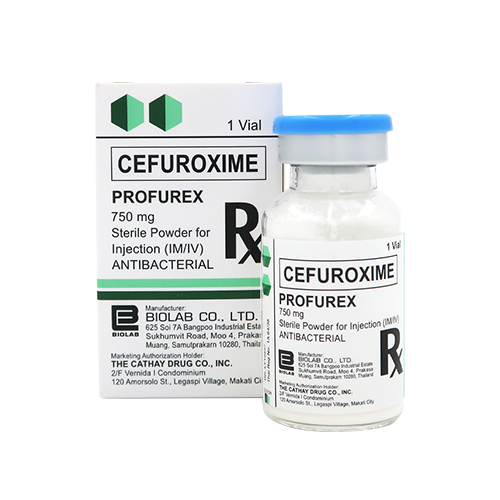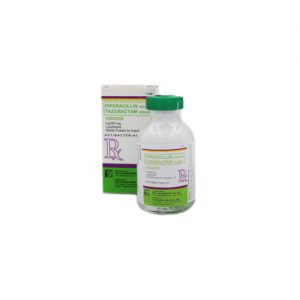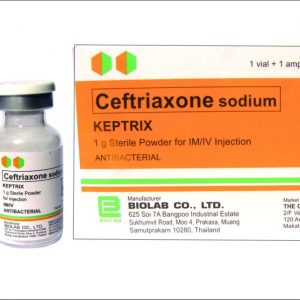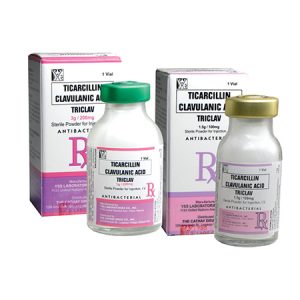Description
The Cathay Drug Co., Inc.
FORMULATION
Each vial contains:
Cefuroxime sodium, USP …………………………………750 mg
equivalent to Cefuroxime
PRODUCT DESCRIPTION
Cefuroxime is a white to faintly powder to which appropriate amount of water is added to prepare a suspension for intramuscular use or a solution for intravenous administration.
Freshly prepared solutions of cefuroxime are yellowish in color, variations in the intensity of this color do not indicate any change in either the efficacy or safety of the product.
PHARMACOLOGICAL PROPERTIES
PROFUREX is a bactericidal cephalosporin antibiotic which is resistant to most β-lactamases and is active against a wide range of gram-positive and gram-negative organisms. It is indicated for the treatment of infections caused by sensitive bacteria. In addition, it is an effective prophylactic agent against post-operative infection in a variety of operations. Usually, it will be effective alone, but when appropriate, it may be used in combination with an aminoglycoside antibiotic or in conjunction with metronidazole, orally or by suppository or injections especially for prophylaxis in colonic surgery.
Mechanism of action
By binding to specific penicillin-binding proteins (PBPs) located inside the bacterial cell wall, cefuroxime inhibits the third and last stage of bacterial cell wall synthesis. Cell lysis is then mediated by bacterial cell wall autolytic enzymes such as autolysins; it is possible that cefuroxime interferes with an autolysin inhibitor.
PHARMACOKINETICS
Absorption and Distribution
After IM injection the peak serum level occurs after about 15 – 60 minutes and range from 26 – 34.9 mcg/mL. After infusion over 30 minutes of single 750 mg dose of cefuroxime results in peak serum concentration of the drug averaging 51.1 mcg/mL/
The apparent volume of distribution of cefuroxime in healthy adults ranges from 9.3 – 15.8 L/1.73 m2. Cefuroxime can be found in bone, synovial fluid and aqueous humor above the minimum inhibitory levels for common pathogens. The blood-brain barrier can be passed by cefuroxime when the meniges are inflamed. The plasma protein binding is about 33 – 50%.
Metabolism and Excretion
Cefuroxime is not metabolized and excreted unchanged principally in urine by both glomelular filtration and renal and tubular secretion. In adults with normal renal function, 90 – 100% of a single IM or IV dose of cefuroxime is excreted unchanged in the urine within 24 hours. Plasma concentrations are reduced via dialysis.
MICROBIOLOGY
PROFUREX is highly active against Staphylococcus aureus, including strains which are resistant to penicillin (but not the rare methicillin-resistant strains), Staphylococcus epidermidis, Haemophilus influenza; Klebsiella spp., Enterobacter spp., Streptococcus pyogenes, Escherichia coli, Streptococcus mitis (viridans group), Clostridium spp., Proteus mirabilis, Proteus rettgeri, Salmonella typhi, Salmonella typhimurium and other Salmonella spp., Shigella spp., Neisseria spp., (including β-lactamase producing strains of N. gonorrheae) and Bordetella pertussis. It is also moderately active against strains of Proteus vulgaris, Proteus morgana and Bacteroides fragilis.
In vitro, the activity of PROFUREX and aminoglycoside antibiotics in combination have shown to be at least additive with occasional evidence of synergy.
INDICATIONS
Cefuroxime sodium (Profurex) is indicated for the following:
- Prophylaxis against infection to abdominal, pelvic, orthopedic, cardiac, pulmonary, esophageal and vascular surgery where there is increased risk for infection
- Respiratory infections e.g. acute and chronic bronchitis, infected bronchiectasis, bacterial pneumonia, lung abscesses, and post-operative chest infections
- Ear, nose and throat infections e.g. sinusitis, tonsillitis and pharyngitis
- Urinary tract infections like acute or chronic pyelonephritis, cystitis
- Soft tissue infections like cellulitis, erysilpelas, peritonitis
- Bone and joint infections like osteomyelitis and septic arthritis
- Obstetric and gynecologic infection, pelvic inflammatory diseases
- Gonorrhea (particularly when penicillin is unsuitable)
- Other infections including septicemia and meningitis
DOSAGE AND ADMINISTRATION
General Dosage Recommendations
Adults
Many infections will respond to 750 mg every 8 hours by intramuscular or intravenous injection. For more severe infections, this dose may be increased to 1.5 g every 8 hours intravenously. The frequency of intramuscular or intravenous injections can be increased to six-hourly if necessary, giving a total dose of 3 to 6 g daily.
Infants and children
Doses of 30 to 100 mg/kg/day, given as three or four divided dose. A dose of 60 mg/kg/day will be appropriate for most infections.
Neonates
Doses of 30 to 100 mg/kg/day, given as two or three divided doses. In the first week of life, the serum half-life of cefuroxime can be three to five times that in adults.
Prophylaxis
The usual dose is 1.5 g IV with induction of anesthesia for abdominal, pelvic and orthopaedic surgeries, but may be supplemented with two 750 mg IM doses 8 and 16 hours later. In cardiac, pulmonary, esophageal and vascular surgeries, the usual dose is 1.5 g IV with induction of anesthesia continuing with 750 mg IM every 8 hours for a further 24 to 48 hours.
Total joint replacement
1.5 g cefuroxime powder may be mixed dry with each pack of methyl metacrylate cement monomer before adding the liquid monomer.
Gonorrhoea
1.5 g cefuroxime should be given as a single dose. This may be given as 2 x 750 mg injection into different sites
Renal impairment
Cefuroxime is excreted via the kidneys. Therefore as such, it is recommended that the dosage of cefuroxime sodium be reduced in patients with impaired renal function to compensate for its slower excretion, except in mild impairment (GFR> 50mL/min). in adults with moderate impairment (GFR 20 – 50 mL/min) only 750 mg every 8 hours is required, with market impairment (GFR 10 – 20 mL/min) 750 mg every 12 hours is sufficient, and with severe impairment (GFR < 10 mL/min) 750 mg once daily is adequate. For patients on dialysis, a further 750 mg dose should be given at the end of each dialysis.
Administration
Intramuscular
Add 1 mL Water for Injection to 250 mg Profurex or 3 mL Water for Injection to 750 mg Profurex. Shake gently to produce an opaque suspension.
Intravenous
Dissolve Profurex in Water for Injection using at least 2 mL for 250 mg, at least 6 mL for 750 mg or 15 mL for 1.5 g.
For short intravenous infusion (e.g. up to 30 minutes) 1.5 g may be dissolved in 50 mL Water for Injection.
These solutions may be given directly into the vein or introduced into the tubing of the giving set if the patient is receiving parenteral fluids.
PROFUREX is compatible with the more commonly used intravenous fluids.
CONTRAINDICATIONS
Contraindicated in patients with known allergy to the cephalosporin group of antibiotics.
PRECAUTIONS
Cephalosporin antibiotics may, in general be given safely to patients who are hypersensitive to penicillins, although cross reactions have been reported. Special care is indicated in patients who have experienced an anaphylactic reaction to penicillin.
Cephalosporin antibiotics at high dosage should be given with caution to patients receiving concurrent treatment with potent diuretics such as furosemide as these combinations are suspected of adversely affecting renal functions. Clinical experience with PROFUREX has shown that this is not likely to be a problem at the recommended dose levels. There is no experimental evidence of embryophatic or teratogenic effects attributable to cefuroxime, but as with all drugs, it should be administered with caution during the early months of pregnancy.
Cefuroxime does not interfere in the enzyme based test for glycosuria. Slight interference with copper reduction methods (Benedict’s, Fehling’s Clinitest) may be observed. However, these should not lead to false positive results, as may be experienced with some other cephalosporins.
PROFUREX may cause false-negative reactions in the ferricyanide test. Some cephalosporins can cause a falsely high reading in the alkaline picrate assay for creatinine, although the degree of elevation is unlikely to be of clinical importance. It is possible that cefuroxime may also interfere with this determination.
As with other antibiotics, prolonged use may result in the over-growth of non-susceptible organisms.
ADVERSE EFFECTS
Adverse reactions have occurred relatively infrequent and have been generally mild and transient in nature. Effects reported include rashes, gastrointestinal disturbances and candida intertrigo.
The principal changes in haematological parameters seen in some patients are decreased haemoglobin concentration and eosinophilia.
A positive Coomb’s test has been found in some patients treated with cefuroxime – this phenomenon can interfere with the crossmatching of blood.
Although there are sometimes transient increases in serum liver enzymes and serum bilirubin, particularly in patients with pre-existing liver disease, there is no evidence of hepatic involvement.
There may also be some variation in the results of biochemical tests of renal function, but these do not appear to be of clinical importance. As a precaution, renal functions should be monitored if this is already impaired.
Transient pain may be experienced at the site of intramuscular injection. This is more likely to occur with higher doses. However, it is unlikely to be a cause for discontinuation of treatment.
OVERDOSAGE
Serum levels of cefuroxime are reduced by dialysis.
PHARMACEUTICAL PRECAUTIONS
The dry powder in vial should be stored at temperatures not exceeding 25°C and protected from light. PROFUREX should not be mixed in the syringe with aminoglycoside antibiotics. Suspension of PROFUREX for intramuscular injection and aqueous solutions for direct intravenous injection retain their potency for 5 hours if kept at temperatures not exceeding 25°C and for 48 hours refrigerated. More diluted solutions, i.e. 1.5 g plus 50 mL Water for Injection, retain their potency for 24 hours if kept at temperatures not exceeding 25°C and for 72 hours if refrigerated.
The color of prepared solution and suspension of PROFUREX may darken on storage.
PROFUREX is compatible with the more commonly used intravenous infusion fluids. It will retain potency for up to 24 hours at room temperature in Sodium Chloride Injection BP 0.9% w/v, 5% Dextrose Injection BP, 0.18% w/v Sodium Chloride plus 4% Dextrose Injection BP and Copound Sodium Lactate Injection BP (Hartmann’s Solution). The pH of 2.74% w/v Sodium Bicarbonate Injection BP considerably affects the color of the solution is not recommended for the dilution of PROFUREX. However, if required, for patients receiving Sodium Bicarbonate Injection by infusion PROFUREX may be introduced into the tube of the giving set.
AVAILABILITY
Cefuroxime (PROFUREX) 750 mg per vial Sterile Powder for Injection (I.M./I.V.) – Box of 1’s
Manufacturer
BIOLAB CO., LTD
625 Soi 7A Bangpoo Industrial Estate, Sukhumvit Road
Moo 4, Prakasa, Muang, Smanutprakarn 10280, Thaniland
Marketing Authorization Holder
The Cathay Drug Co., Inc.
2/F Vernida I Condominium
120 Amorsolo St. Legaspi Village, Makati City
Date of revision: November 2016






Reviews
There are no reviews yet.